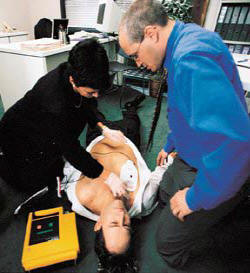![]() Letter from a HEART ATTACK Survivor
Letter from a HEART ATTACK Survivor
With help from an AED
(Opens in separate window)


AEDs are specially designed for easy use by a "first responder", who would be the first person to typically arrive on the scene of a medical emergency. A first responder can be an emergency medical services worker, a firefighter or police officer, or it can be a layperson with minimal AED training.
Time to defibrillation, the most critical factor in sudden cardiac arrest (SCA) survival, can be reduced if an AED is "on-site" and can be brought to the victim quickly. This is one of the reasons that survival rates improve in communities with active AED programs. Remember, every minute that passes before defibrillation reduces survival rates by 7-10 percent. The goal is to improve SCA survival rates. On-site AEDs can make the difference.